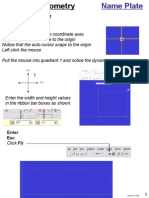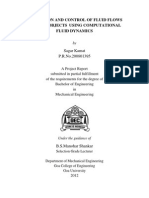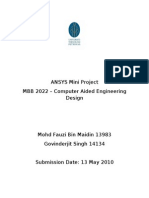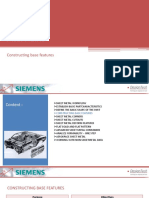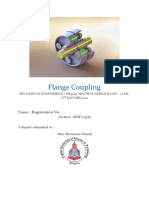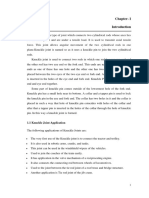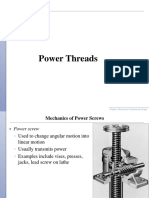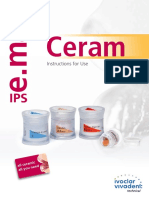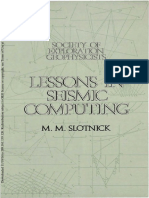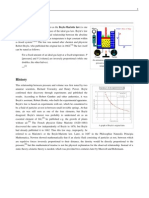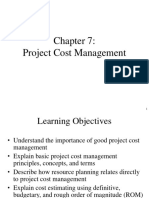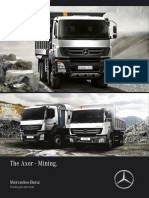Leaf Spring Analysis
Leaf Spring Analysis
Uploaded by
Daniel AlvaradoCopyright:
Available Formats
Leaf Spring Analysis
Leaf Spring Analysis
Uploaded by
Daniel AlvaradoOriginal Title
Copyright
Available Formats
Share this document
Did you find this document useful?
Is this content inappropriate?
Copyright:
Available Formats
Leaf Spring Analysis
Leaf Spring Analysis
Uploaded by
Daniel AlvaradoCopyright:
Available Formats
International Journal of Mechanical Production Engineering Research and Development (IJMPERD) ISSN 2249-6890 Vol.
3, Issue 1, Mar 2013, 155-162 TJPRC Pvt. Ltd.
DESIGN AND ANALYSIS OF AUTOMOTIVE MULTI-LEAF SPRINGS USING COMPOSITE MATERIALS
U. S. RAMAKANTH & K. SOWJANYA Assistant Professors, SVP Engineering College, Andhra University, Vizag, Andhra Pradesh, India
ABSTRACT
Leaf springs are one of the oldest suspension components they are still frequently used, especially in commercial vehicles. The automobile industries have shown interests in replacement of steel springs with composite leaf springs due to high strength to weight ratio. This work is carried out on multi leaf springs having nine leaves used by a commercial vehicle. A Finite element approach for analysis of a multi leaf springs using Ansys software is carried out. The model is generated using solid works and imported in Ansys. The material of the leaf springs is 65Si7 (SUP9), composite leaf springs and hybrid leaf springs. Fatigue analysis of leaf springs is carried out for steel leaf springs, and Static analysis for steel leaf springs, composite leaf springs and hybrid leaf springs.
KEYWORDS: Leaf Springs, Steel Leaf Springs, Composite Leaf Springs, Hybrid Leaf Springs INTRODUCTION
Increasing comptetion and innovations in automobile sector tends to modify the existing products or replacing old products by new and advanced material products. Also to meet the needs of the natural resource conservation and energy and economy, the automobile manufacturers have been attempting to reduce the weight of the vehicle in recent years [1]. A suspension system of a vehicle is also an area where these innovations are carried out regularly. More efforts are taken in order to increase the comfort of the user. Appropriate balance of comfort riding qualities and economy in the manufacturing of leaf springs becomes an obvious necessity. Many past recorded data shows that steel leaf springs are manufactured by EN45,EN45A,60Si7, EN47,and 50CrMoCV etc these materials are widely used for the manufacture of the conventional multi leaf springs. The introduction of the composite materials made it possible to reduce the weight of the leaf springs without any reduction of load carrying capacity and stiffness. Studies were conducted on the application of the composite materials for automobile suspension system (leaf springs) [2,3]. Compared to steel spring, the composite leaf spring is found to have 64.95% higher stiffness and 126.98% higher natural frequency than that of existing steel leaf springs [2].Multi leaf springs used in the automotive vehicles normally consist of full length leaves and graduated length leaves. The specimen under this research work consists of nine leaves. Finite element analysis using ANSYS software has been carried on conventional leaf springs to determine the safe stress and pay loads and it is observed that inner side of eye sections [4].Composite mono leaf springs were manufactured with integral eye and tested under static loading condition. Also fatigue life prediction was done to ensure a reliable number of life cycles [5]. Leaf springs were modelled in conventional way and simulated for the kinematic and dynamic comparatives [6]. An artificial genetics approach for the design optimisation of the composite leaf springs were conducted [7]. Static testing and finite element analysis have been conducted to obtain the characteristics of the spring. Load deflection curves and strain measurement as a function of loads for the three design tested have been plotted for the comparison with the FEA predicted values [8]. Fatigue strength of shot peening leaf spring from laboratory samples of EN45 steel spring is calculated. A lot of research has been done to
156
U. S. Ramakanth & K. Sowjanya
improve fatigue strength of material by creating compressive residual stress field in there surfaces through shot peening [9]. A double tapered beam for automotive suspension leaf springs has been designed and optimized [10].Demonstration of the feasibility of using the program as a tool in establishing the initial design consideration s and in developing of preliminary design was done [11]. Investigation of the fundamental properties of the dimensioning of the FRP leaf spring made from GFRP to replace four steel springs [12]. The fatigue strength of 65Si7 spring steel has been evaluated experimentally as a function of shot peening parameters for the application in automotive vehicles [13]. The main objective of this work is to perform finite element analysis of multi leaf springs of three different combinations and to find the bending stresses, to perform static analysis of the three combinations.
METHODS
Materials and Properties Material properties and Design parameters of steel leaf springs, composite leaf springs, hybrid leaf springs: Design parameters of the multi leaf spring used in this work are: Total span length (eye to eye): 1450mm Number of full length leaves: 02 Length of full length leaves (L-1 and L-2): 1450 mm each Width of all leaves: 70mm Thickness of all leaves: 12mm Number of graduated length leaves: 07 Length of graduated length leaves; (L-3, L-4, L-5, L-6, L-7, L-8 and L-9): 1320mm, 1140mm, 940mm, 800mm, 640mm, 464mm & 244mm respectively. The different parameters related to steel leaf springs are tabulated in the table1 below: Table 1: Material Properties Parameter Material selected-steel Youngs modulus, E Poissons Ratio BHN Ultimate Tensile Strength Tensile strength Yield Spring stiffness Mass Normal static loading Density Behaviour Value 65Si7 2.1*105 N/mm2 0.266 400-425 460 Mpa 250 Mpa 221.5 N/mm2 58.758 kg 35000N 0.00000785Kg/mm3 Isotropic
Material properties of E glass/ Epoxy (GFRP): The different parameters related to GFRP leaf springs are tabulated in the table below:
Design and Analysis of Automotive Multi-Leaf Springs Using Composite Materials
157
Table 2: Material Properties Parameter Tensile modulus along X direction Tensile modulus along Y direction Tensile modulus along Z direction Tensile strength Compressive strength Shear modulus along XY direction Shear modulus along YZ direction Shear modulus along ZX direction Poisons ratio along XY direction Poisons ratio along YZ direction Poisons ratio along ZX direction Density of the material Behaviour Value 34000 Mpa 6530 Mpa 6530 Mpa ` 900 Mpa 450 Mpa 2433 Mpa 1698 Mpa 2433 Mpa 0.217 0.366 0.217 2.6*103 kg/mm3 orthotropic
Material properties of Hybrid leaf springs: Hybrid leaf springs are just alternate layers of steel 65Si7 and Epoxy GFRP. Leaf springs are made out of flat plates. The advantage of leaf spring over helical spring is that the ends of the spring may be guided along a definite path as it deflects to act as a structural member in addition to the energy absorbing device. Thus leaf spring may carry lateral loads, brake torque, driving torque, in addition to the shocks. The ability to
absorb and store more amount of energy ensures the comfortable operation of a suspension system. However, the problem of heavy weight of spring is still persistent. This can be remedied by introducing composite material, in place of steel in the conventional leaf spring. Research has indicated that the results of E-glass/Epoxy were found to have good characteristics for storing strain energy [2], It is also proved through the further stages of this research. So a virtual model of the three combinations of the leaf springs are modelled using Solid works 12 and static analysis is done by importing these models into Ansys 12 software package. Modelling For the above given specification of the leaf spring, the static analysis is performed using ANSYS to find the stresses and deflection. After modelling of the leaf spring with given specifications it is subjected to analysis. The Analysis involves the following discretization called meshing, boundary conditions and loading. A virtual model of each leaf is modelled separately, and then it is assembled together using solid works 12 (figure 1). This model is then imported into Ansys 12 for conducting static and fatigue analysis. Same model is used for the static analysis with three different materials steel 65Si7, epoxy GFRP, and hybrid leaf springs. These materials are selected in the Ansys software by inserting the appropriate material properties and the analysis of the corresponding material is done. Meshing of the Leaf Spring Model Meshing involves division of the entire of model into small pieces called elements. This is done by meshing. It is convenient to select the free mesh because the leaf spring has sharp curves, so that shape of the object will not alter. To mesh the leaf spring the element type must be decided first. Here, the element type is solid 72. Fine mesh is created with 16916 nodes and 2212 elements. After meshing is done the contacts and targets must be defined in between individual leafs of the leaf spring (figure 2). The material properties of the given leaf spring are given in table 1 and table 2.
158
U. S. Ramakanth & K. Sowjanya
Applying Boundary Conditions The leaf spring is mounted on the axle of the automobile; the frame of the vehicle is connected to the ends of the leaf spring. The ends of the leaf spring are formed in the shape of an eye. The front eye of the leaf spring is coupled directly with a pin to the frame so that the eye can rotate freely about the pin but no translation is occurred. The rear eye of the spring is connected to the shackle which is a flexible link; the other end of the shackle is connected to the frame of the vehicle. The nodes of rear eye of the leaf spring are constrained in all translational degrees of freedom; Figure 3 shows the boundary conditions of the leaf spring. The load is applied along Fy direction as shown in Figure 3. Same procedure is conducted for composite leaf springs and hybrid leaf springs.
Figure 1: Model of Leaf Springs Using Solid Works Static Analysis
Figure 2: Meshed Model Using Ansys
As the finite element analysis of multi leaf spring is performed using ANSYS-12 workbench. The multi leaf spring for conventional steel showing deflection and bending stress under load is shown in figure-4 and Figue-5.From Figure 4, it is obvious that maximum stress developed is at inner side of the eye sections i.e. the red colour indicates maximum stress, because the constraints applied at the interior of the eyes. Since eyes are subjected to maximum stress, care must be taken in eye design and fabrication and material selection. The material must have good ductility, resilience and toughness to avoid sudden fracture. Thus factor of safety must be increased near the eye. The same procedure is carried out for composite leaf springs, hybrid leaf springs, by changing the material properties of the corresponding materials.
Design and Analysis of Automotive Multi-Leaf Springs Using Composite Materials
159
Figure 3: Boundary Conditions
Figure 4: Bending Stress (Von-Misses Stress) Fatigue Analysis
Figure 5: Total Deflection
The finite element model from earlier stage was applied with the SAE transmission loading to simulate the actual road loading condition. In this simulation, the Goodman approach, Soderbergs theory, Gerbers theory and mean stress curves has been used. The material that has been used for the simulation of the spring is 65Si7(SUP 9)steel, which is normally used for the spring fabrication. Ultimate Tensile Strength of the material is 460 Mpa. The results obtained using ANSYS 12 software. . The results are compared and the theory which gives the lowest value of life and the highest value is chosen to be best in the analysis of steel leaf springs Loading data is chosen as history data of SAE transmission and is applied. Life data analysis: This is carried out by applying a load of 1000N and the analysis is carried out by the above mentioned four approaches. Goodmans and Gerbers approach: Using the Gerbers theory the life data obtained is similar to the Goodmans theory. Mean stress theory approach: Using mean stress curves it is observed that there are less red coloured region (fig 11) compared to the Goodmans and Gerbers hence this theory is not preferred for the life data analysis of the leaf springs.
160
U. S. Ramakanth & K. Sowjanya
Soderbergs approach: In this approach it is seen that red coloured region is greater (figure 13). It shows less life compared to other approaches, hence it is most preferred in the analysis of the leaf springs.
Design and Analysis of Automotive Multi-Leaf Springs Using Composite Materials
161
RESULTS AND DISCUSSIONS
Static Analysis A graph is plotted as shown in Figure 6 between Load versus Von-mises stress with Load on the X-Axis and Vonmises stress on the Y-Axis. It is seen that from the graph that when load increases the bending stress increases linearly. So load-stress graph gives the straight line relationship. Also it is seen that hybrid leaf springs has properties between the steel leaf springs and composite leaf springs. Table 3: Stress Analysis Using FEA Software Stress GFRP Leaf Springs (Mpa) 8.401 16.802 25.203 33.604 42.005
Load (N) 1000 2000 3000 4000 5000
65Si7 Steel Leaf Springs (Mpa) 9.242 18.484 27.726 36.968 46.21
Hybrid Leaf Springs (Mpa) 8.812 17.624 26.436 35.248 44.06
Fatigue Analysis Fatigue analysis is conducted with four approaches namely Goodmans approach (fig8), Gerbers approach, mean stress approach (fig11) and Soderbergs approach (fig 13), by applying a load of 1000N, with a loading condition from history data SAE Transmission. From the above said approaches it is seen that Soderbergs approach shows a maximum value of life 1.171*107 cycles which is represented in blue colour in the life data figure and the least value of life is shown in red colour. And from the Soderbergs approach we find that the red coloured region is greater it shows less life compared to other approaches, hence it is most preferred in the analysis so the designer can increase the safety of the leaf springs.
CONCLUSIONS
Under the same static load conditions the stresses in leaf springs are found with great difference. Stresses in composite leaf springs is found out to be less as compared to the conventional steel leaf springs, also a new combination of steel and composite leaf springs (hybrid leaf springs) are given the same static loading and is found to have values of stresses in between that of steel and composite leaf springs. Conventional 65Si7 (SUP9) leaf springs were found to weight about 58.757kgs, while the composite leaf springs weighed only 19.461kgs, and the hybrid leaf springs weighed 41.14 kgs for the same specifications. The cost of the GFRP composite is very high when compared to conventional steel leaf springs, while the cost of hybrid leaf springs may be lesser when compared to GFRP composite leaf springs. The fatigue analysis of the steel leaf springs are carried with four approaches, Soderbergs approach is found out to give better results for the analysis of life data for leaf springs.
REFERENCES
1. H.A.Al-Qureshi,Automobile leaf spring from composite materials,Journal of Material Processing Technology 118 (2001) 58-61.
162
U. S. Ramakanth & K. Sowjanya
2.
Senthil Kumar, Sabapathy Vijayarangan, Analytical and experimental studies on fatigue life prediction of steel and composite multi-leaf springs for light passenger vehicles using life data analysis,Journal of Material Processing Technology(2001).
3.
Daugherty.R.L, Composite leaf springs in heavy truck applications, International conference on composite material procedings of japan US conference, Tokyo 1981:pp 529-538
4. 5.
G.Harinath Gowd, Venugopal Gowdstatic analysis of leaf springs, VOL 4 8th aug-2012 IJEST Shiva Shankar and Vijayarangan,Mono composite leaf springs for light weight vehicle design, End joint, analysis and testing, Material science Vol 12 Nov 3 2006.
6. 7.
Nikolas Philipson and Modelan A BLeaf spring modeling, science park S E 22307,lund sweden I.Rajendran, S.Vijayarangan, optimal design of composite leaf springs using genetic algorithm, Computer and Structure 79 (2001) 1121-1129
8.
Hou J.P Cherrualt J Y,evolution of the eye-end design of a composite leaf spring for heavy axle loads, composite structure, 28,351-358(2006)
9.
M.L.Agarwal, V.P.Agarwal,A stress approach model fpr prediction of fatigue life by shot peening of EN45 steel spring,International Journal of Fatigue 28 (2006) 1845-1853.
10. Yu.W.J, Kinm.H.C,Double Tapered FRP Beam from Automotive suspension leaf springs, Composite structures 1988 pp 279-300. 11. Corvi Andrea , A preliminary approach to composite beam design using FEM analysis, Composite structures 16, 259-275. 12. Yu.W.J, Kinm.H.C,Double Tapered FRP Beam from Automotive suspension leaf springs, Composite structures 1988 pp 279-300. 13. Aggrwal.M.L and Chawla, Issuses in fretting fatigue design of shot peenede leaf springs, IJEMS 14, 414
You might also like
- Topology Optimization of A Jet Engine Bracket Using SolidworksDocument46 pagesTopology Optimization of A Jet Engine Bracket Using SolidworksAhmedNo ratings yet
- Design Guide For Air Slide Conveyor PDFDocument4 pagesDesign Guide For Air Slide Conveyor PDFDaniel0010100% (2)
- Name Plate Directions Mastercam XDocument30 pagesName Plate Directions Mastercam Xchicho6404100% (2)
- Designing A StaplerDocument41 pagesDesigning A StaplerEmmanuel Morales ChilacaNo ratings yet
- Simulation and Control of Fluid Flows Around Objects Using Computational Fluid DynamicsDocument54 pagesSimulation and Control of Fluid Flows Around Objects Using Computational Fluid DynamicsSagar KamatNo ratings yet
- Va 502 PDFDocument59 pagesVa 502 PDFRodrigoNo ratings yet
- Design Optimization and Analysis of Leaf Spring Using Static Load ConditionsDocument7 pagesDesign Optimization and Analysis of Leaf Spring Using Static Load Conditionshariram palanisamyNo ratings yet
- Static and Dynamic Analysis of HCR Spur Gear Drive UsingDocument54 pagesStatic and Dynamic Analysis of HCR Spur Gear Drive Usingjr-parshanthNo ratings yet
- Design and Analysis of Parabolic Leaf SpringDocument5 pagesDesign and Analysis of Parabolic Leaf Springvijayan m gNo ratings yet
- ANSYS Mini ProjectDocument16 pagesANSYS Mini Projectputera_syah_2100% (1)
- Datasheet For Steel Grades Carbon Steel SUP11ADocument2 pagesDatasheet For Steel Grades Carbon Steel SUP11AswatkoolNo ratings yet
- Machine Design Practice July 2019 Assignment IIT MadrasDocument39 pagesMachine Design Practice July 2019 Assignment IIT MadrasVishwajit HegdeNo ratings yet
- Me8793 Ppce Unit IVDocument54 pagesMe8793 Ppce Unit IVjeevan ram vNo ratings yet
- Knuckle Joints DesignDocument10 pagesKnuckle Joints DesignKvrd Prasad100% (1)
- Yared Love Gear Box DesignDocument117 pagesYared Love Gear Box DesignYigremachew bizualew AyenewNo ratings yet
- Parametric Analysis in ANSYS Workbench Using ANSYS FluentDocument48 pagesParametric Analysis in ANSYS Workbench Using ANSYS FluentLok WpNo ratings yet
- A ProjectDocument14 pagesA Projectajay0% (1)
- Durability Assessments of Motorcycle Handlebars Ken-Yuan Lin, 2005 XXXXXDocument25 pagesDurability Assessments of Motorcycle Handlebars Ken-Yuan Lin, 2005 XXXXXjaydeepnaruleNo ratings yet
- CNC and MastercamDocument18 pagesCNC and MastercambellaNo ratings yet
- Deform Friction Stir WeldingDocument6 pagesDeform Friction Stir Weldingramkumar121100% (1)
- Thermal Deformation Analysis of Automotive Disc Brake SquealDocument26 pagesThermal Deformation Analysis of Automotive Disc Brake SquealNg Guo LiangNo ratings yet
- 3 Design and Analysis of Gearless TransmissionDocument68 pages3 Design and Analysis of Gearless TransmissionRåjêßh M Ińtü100% (2)
- Design & Fabrication of Soft Robotic Gripper For Handling Fragile ObjectsDocument42 pagesDesign & Fabrication of Soft Robotic Gripper For Handling Fragile Objectssaisrini98No ratings yet
- Fluent Tutorials 1Document912 pagesFluent Tutorials 1cagdasozen100% (1)
- Classical Kinematis CHP 1-14Document95 pagesClassical Kinematis CHP 1-14kullayot suwantarojNo ratings yet
- BoltsDocument18 pagesBoltsSatyaKrishna Palla100% (1)
- Final Project Report 1Document99 pagesFinal Project Report 1Sikander GirgoukarNo ratings yet
- Summer Internship Project Work OnDocument28 pagesSummer Internship Project Work OnVikramNo ratings yet
- K.K.I.W.E.E.R Department of Mechanical Engineering, Nashik 1Document18 pagesK.K.I.W.E.E.R Department of Mechanical Engineering, Nashik 1kshitijNo ratings yet
- ANSYS - Placement Test Problem StatementDocument25 pagesANSYS - Placement Test Problem StatementMahesh GarlankaNo ratings yet
- Advanced Sheet Metal CommandsDocument26 pagesAdvanced Sheet Metal CommandsAnil VaswaniNo ratings yet
- Mech Engg Syllabus Modified (R10) 11.3.2012Document57 pagesMech Engg Syllabus Modified (R10) 11.3.2012Srimanthula SrikanthNo ratings yet
- Pneumatic Sheet Metal Shearing MachineDocument21 pagesPneumatic Sheet Metal Shearing MachineGamerNo ratings yet
- Spur GearDocument67 pagesSpur GearJeky KurniawanNo ratings yet
- 2 (B) Design of Knuckle JointDocument16 pages2 (B) Design of Knuckle JointOppo A7No ratings yet
- Pneumatic Speed Breaker With Day Night Control (PSB)Document40 pagesPneumatic Speed Breaker With Day Night Control (PSB)Giri TharanNo ratings yet
- Is 7054 1973Document16 pagesIs 7054 1973m_verma21No ratings yet
- Motorized Smart Turning MechanismDocument3 pagesMotorized Smart Turning MechanismSUMEET SINGHNo ratings yet
- Dual Energy Generator Using Solar & Tidal PowerDocument4 pagesDual Energy Generator Using Solar & Tidal PowerTysoñ ßNo ratings yet
- Constructing Base FeaturesDocument42 pagesConstructing Base FeaturesAnil VaswaniNo ratings yet
- Flange Coupling Lab PDFDocument25 pagesFlange Coupling Lab PDFAli Raza MalikNo ratings yet
- Knuckle Joint Stress AnalysisDocument22 pagesKnuckle Joint Stress AnalysisAshutosh girdharNo ratings yet
- Measurement Lab Manual RADocument20 pagesMeasurement Lab Manual RAVinayak SharmaNo ratings yet
- Fuel System in Si and Ci EngineDocument33 pagesFuel System in Si and Ci EngineShuguta LatiNo ratings yet
- Me6503 Dme Unit 2 Study Notes 2015Document27 pagesMe6503 Dme Unit 2 Study Notes 2015Bala MuruganNo ratings yet
- P6 Presentation-30-3-2021Document68 pagesP6 Presentation-30-3-2021Moiz MalikNo ratings yet
- Finite Element Analysis of Human Femur BoneDocument14 pagesFinite Element Analysis of Human Femur BoneAreez KhanNo ratings yet
- MAE322PowerThreads PDFDocument29 pagesMAE322PowerThreads PDFabbieNo ratings yet
- Design and Analysis of Connecting RodDocument3 pagesDesign and Analysis of Connecting RodChandra Sekar50% (2)
- Modelling and Analysis 1Document35 pagesModelling and Analysis 1Larry SmithNo ratings yet
- Djj5133 Engineering Design Case Study 2 Lecturer Name: Mohd Fuaad Bin Fesul Name:Muhammad Haziq Hidayat Bin Rahim MATRIX NO: 23DKM18F2029Document44 pagesDjj5133 Engineering Design Case Study 2 Lecturer Name: Mohd Fuaad Bin Fesul Name:Muhammad Haziq Hidayat Bin Rahim MATRIX NO: 23DKM18F2029Kubheran SelvathuraiNo ratings yet
- 322 F22 Lecture17 Yield Criteria Flow RulesDocument41 pages322 F22 Lecture17 Yield Criteria Flow Ruleslokesh100% (1)
- BIW - BeadsDocument2 pagesBIW - BeadsArvind97No ratings yet
- Damage Mechanics in Metal Forming: Advanced Modeling and Numerical SimulationFrom EverandDamage Mechanics in Metal Forming: Advanced Modeling and Numerical SimulationRating: 4 out of 5 stars4/5 (1)
- Dynamic Analysis of Leaf SpringDocument9 pagesDynamic Analysis of Leaf SpringTHEBESTNo ratings yet
- Design & Analysis of Mono Composite Leaf Spring: Volume 2 Issue2 PP 103-107 May 2013Document5 pagesDesign & Analysis of Mono Composite Leaf Spring: Volume 2 Issue2 PP 103-107 May 2013Rajesh Kumar PNo ratings yet
- Design and Analysis of A Suspension Coil Spring PDFDocument7 pagesDesign and Analysis of A Suspension Coil Spring PDFCiobanu MihaiNo ratings yet
- A Comparative Study of Standard and Casted Eye Design of A Mono Leaf SpringDocument9 pagesA Comparative Study of Standard and Casted Eye Design of A Mono Leaf SpringamitdhamijaNo ratings yet
- Design Analysis and Experimental ValidatDocument7 pagesDesign Analysis and Experimental Validatnavneet.dypcetNo ratings yet
- IPS E-Max CeramDocument64 pagesIPS E-Max CeramMihai Cucu100% (2)
- Lessons in Seismic Computing - A Memorial T - Morris Miller SlotnickDocument279 pagesLessons in Seismic Computing - A Memorial T - Morris Miller Slotnickalejandra coloradoNo ratings yet
- Boyle's LawDocument4 pagesBoyle's LawEn CsakNo ratings yet
- Spare Parts List Hydraulic Bulkpulverizer: BP 1900 / BP 1900 RDocument24 pagesSpare Parts List Hydraulic Bulkpulverizer: BP 1900 / BP 1900 RredNo ratings yet
- Section ModulusDocument6 pagesSection ModulusKARTHIK SG100% (1)
- Direct-Current MachinesDocument108 pagesDirect-Current MachinesHenry KabasaNo ratings yet
- StaircaseDocument9 pagesStaircaseubhutada100% (2)
- Digila Bfreh (Uy) (1sem) : EqtleDocument15 pagesDigila Bfreh (Uy) (1sem) : EqtleSumanth DeshpandeNo ratings yet
- 2020 - Petrotekno Public Training ScheduleDocument1 page2020 - Petrotekno Public Training Scheduleargya AwangNo ratings yet
- Project Cost ManagementDocument33 pagesProject Cost ManagementwossenNo ratings yet
- Logistic Regression Model For Prediction of Roof Fall Risks in Bord and Pillar Workings in Coal Mines - An ApproachDocument9 pagesLogistic Regression Model For Prediction of Roof Fall Risks in Bord and Pillar Workings in Coal Mines - An ApproachDURGAM HIMALAYNo ratings yet
- Bolt Weight CalDocument10 pagesBolt Weight CalwahyuokkNo ratings yet
- D Internet Myiemorgmy Intranet Assets Doc Alldoc Document 12078 en 206 Conformity Testing For Concrete StrengthDocument11 pagesD Internet Myiemorgmy Intranet Assets Doc Alldoc Document 12078 en 206 Conformity Testing For Concrete StrengthHarish Kumar MahavarNo ratings yet
- StabilityDocument8 pagesStabilitySenthil KumarNo ratings yet
- Translucent DatabaseDocument17 pagesTranslucent DatabaseAkshith GunasekaranNo ratings yet
- NSTB PDFDocument218 pagesNSTB PDFRandy LangleyNo ratings yet
- Management Theories For BEd STUDENTSDocument9 pagesManagement Theories For BEd STUDENTSPratheesh PkNo ratings yet
- Aspen Flare System AnalyzerDocument1 pageAspen Flare System AnalyzerMiftah MasrurNo ratings yet
- CaseStudy MindanaoStateUniversityDocument9 pagesCaseStudy MindanaoStateUniversityJessa Mae Banse LimosneroNo ratings yet
- Ochure 18.4.22Document46 pagesOchure 18.4.22Sanket GutteNo ratings yet
- User Manual Jamicon 3vaav eDocument15 pagesUser Manual Jamicon 3vaav ematwan29No ratings yet
- Brosur Axor 2528 CH PDFDocument4 pagesBrosur Axor 2528 CH PDFyogi ganda pratamaNo ratings yet
- BMW XDrive DSCDocument25 pagesBMW XDrive DSCManual100% (2)
- Edm Shahrul DKM4B 07DKM22F1011Document8 pagesEdm Shahrul DKM4B 07DKM22F1011Young RussleNo ratings yet
- Bluesil BP 9400Document3 pagesBluesil BP 9400hector mauricio paez cantorNo ratings yet
- Shopping Mall Case Study NOV 24 2015Document20 pagesShopping Mall Case Study NOV 24 2015cyo3fff100% (1)
- Surveying 235 Lab ManualDocument23 pagesSurveying 235 Lab ManualcarsonNo ratings yet
- Solar Absorption CoolingDocument10 pagesSolar Absorption CoolingSoham MallickNo ratings yet


